突变特征定义了壶腹癌的免疫和wnt相关亚型
IF 23
1区 医学
Q1 GASTROENTEROLOGY & HEPATOLOGY
引用次数: 0
摘要
背景与目的壶腹癌(AMPAC)的分类基于形态学和免疫组织化学。这种分类缺乏预后可靠性和独特的遗传关联。我们应用了一种整合基因组学方法来表征AMPAC患者,探索可能指导个性化治疗的分子亚型。我们分析了170例AMPAC患者的突变景观。该发现包括110对肿瘤/正常配对,验证包括60名患者。在肿瘤亚群中,我们询问了转录组和DNA甲基化组。根据突变特征并与分子和临床特征相关对患者进行分层。为了评估肿瘤和免疫细胞,对22个肿瘤进行了独立的组织形态学和数字病理学评估。结果我们通过独立于组织形态学的突变特征定义了三个患者群。聚类1 (C1)由DNA 5-甲基胞嘧啶自发脱氨和缺陷错配修复定义。C2和C3与转录偶联核苷酸切除修复的活性有关,但C3通过聚合酶eta突变过程进一步定义。C1-2显示Wnt通路改变、DNA甲基化谱异常、免疫细胞排斥和患者预后不良。这些特征与CpGs中C>T改变引起的超突变表型相关。C3患者总生存率的提高与免疫相关通路的激活、免疫浸润和免疫抑制检查点基因的表达升高有关。结论免疫原性和Wnt通路相关,由突变特征强调,定义了患者对免疫治疗或Wnt通路抑制剂的前瞻性敏感性。这强调了一种新的基于突变特征的AMPAC分类,具有预后潜力,这对AMPAC患者的亚组特异性管理具有前瞻性意义。数据可以在一个公共的、开放访问的存储库中获得。与本研究相关的数据集包含在补充信息中,可在GEO获取,登录号为GSE159099。本文章由计算机程序翻译,如有差异,请以英文原文为准。
Mutational signatures define immune and Wnt-associated subtypes of ampullary carcinoma
Background and objective Ampullary carcinoma (AMPAC) taxonomy is based on morphology and immunohistochemistry. This classification lacks prognostic reliability and unique genetic associations. We applied an approach of integrative genomics characterising patients with AMPAC exploring molecular subtypes that may guide personalised treatments. Design We analysed the mutational landscapes of 170 patients with AMPAC. The discovery included 110 tumour/normal pairs and the validation comprised 60 patients. In a tumour subset, we interrogated the transcriptomes and DNA methylomes. Patients were stratified based on mutational signatures and associated with molecular and clinical features. To evaluate tumour and immune cellularity, 22 tumours were independently assessed histomorphologically and by digital pathology. Results We defined three patient clusters by mutational signatures independent of histomorphology. Cluster 1 (C1) was defined by spontaneous deamination of DNA 5-methylcytosine and defective mismatch repair. C2 and C3 were related to the activity of transcription-coupled nucleotide excision repair but C3 was further defined by the polymerase eta mutational process. C1–2 showed enrichment of Wnt pathway alterations, aberrant DNA methylation profiles, immune cell exclusion and patients with poor prognosis. These features were associated with a hypermutator phenotype caused by C>T alterations at CpGs. C3 patients with improved overall survival were associated with activation of immune-related pathways, immune infiltration and elevated expression of immunoinhibitory checkpoint genes. Conclusion Immunogenicity and Wnt pathway associations, emphasised by the mutational signatures, defined patients with prospective sensitivity to either immunotherapy or Wnt pathway inhibitors. This emphasises a novel mutational signature-based AMPAC classification with prognostic potential, suggesting prospective implications for subgroup-specific management of patients with AMPAC. Data are available in a public, open access repository. Data sets relevant to this study are included in the supplementary information and available at GEO with accession number GSE159099.
求助全文
通过发布文献求助,成功后即可免费获取论文全文。
去求助
来源期刊

Gut
医学-胃肠肝病学
CiteScore
45.70
自引率
2.40%
发文量
284
审稿时长
1.5 months
期刊介绍:
Gut is a renowned international journal specializing in gastroenterology and hepatology, known for its high-quality clinical research covering the alimentary tract, liver, biliary tree, and pancreas. It offers authoritative and current coverage across all aspects of gastroenterology and hepatology, featuring articles on emerging disease mechanisms and innovative diagnostic and therapeutic approaches authored by leading experts.
As the flagship journal of BMJ's gastroenterology portfolio, Gut is accompanied by two companion journals: Frontline Gastroenterology, focusing on education and practice-oriented papers, and BMJ Open Gastroenterology for open access original research.
 求助内容:
求助内容: 应助结果提醒方式:
应助结果提醒方式:


